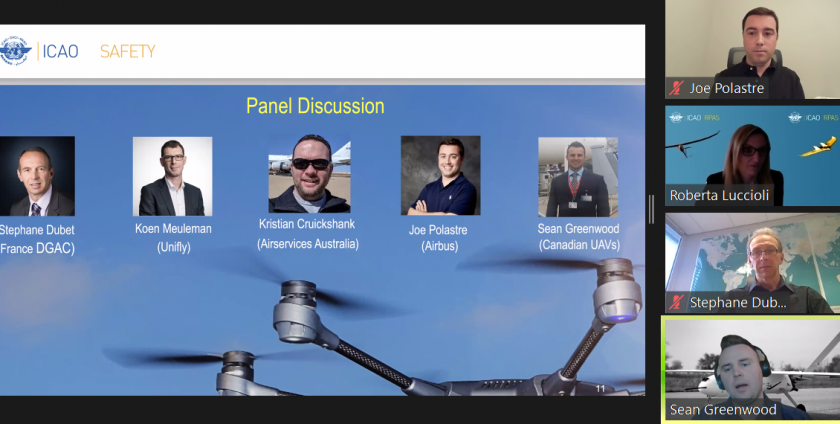“Unmanned Aerial Systems (UAS) operations require aeronautical data and information. The problem is, there is a lack of ICAO guidance on how the data should be made available, what form is suitable for exchanges between Unmanned Traffic Management (UTM) and Air Traffic Management (ATM), and within UTM,” explains Roberta Luccioli, ICAO Aeronautical Information Management (AIM) Technical Officer, moderator at the ICAO webinar entitled AIM for UTM on 11 March 2021. The variety and complexity of UAS operations calls for a different approach to internationally-agreed standards and procedures used to ensure data quality in manned aviation.
The ICAO UTM Exploratory Project is researching and defining a work programme to help states and service providers understand how to facilitate initial AIM services. Additionally, ICAO is developing guidance material and a ‘catalogue’ to describe UTM AIM requirements, to eventually be followed by Standards And Recommended Practices (SARPS).
“ICAO guidance needs to consider the roles and responsibilities of service providers; the scope of the data and quality requirements (which will depend on use-cases); how data is originated, collected, sourced and updated; the UTM service management system (within a SWIM environment); define the quality requirements for the various services supporting UTM; and ensure interoperability within the UTM system community and with ATM,” says Roberta Luccioli. In the short term, segregated operations mean different roles and responsibilities for air navigation service providers (ANSPs) and UTM service providers (USPs) with specific governance to ensure co-operation between the two. In the longer term, tailored rules will support manned and unmanned operations in the same environment. “In this context, interaction between stakeholders will be lower as technology will be in an advanced state of maturity to facilitate integration between ATM and UTM systems.”
There are still likely to be differences between states as services are delegated to third parties, but aeronautical information will provide a single point of truth for both ATM and UTM and will be based on digital data-sharing. “UTM might not need requirements for operations across borders.”
Airservices Australia sees UTM as an opportunity for a “clean-slate design to allow the UTM sector to flourish and not be influenced by legacy ways of doing things,” says Kristian Cruickshank, Integrated Airspace programme manager. “We are looking at a highly cohesive, low coupling environment for UTM and ATM. We expect in 10 or 20 years’ time UTM to be the blueprint or replacement for traditional ATM systems we are using now. We call this concept ATM 2.0.” The concept retains the fundamental principles of safety, data assurance, data integrity and design assurance that are “baked into aviation”. He points out that while some progress has been made with formats such as SWIM and AIXM in recent years, adjacent sectors such as the geospatial industry have already developed fully-digitalised data formats that support processing and distribution systems.
Kristian Cruickshank identifies six main areas new datasets need to address: “Accuracy of the data, resolution of the data, applicability, accessibility, format, and timeliness.”
“It’s about adopting digital principles of the Internet. UTM is driving digitisation of airspace management,” says Dr Joe Polastre, Airbus Head of UTM Products. Airbus’ own involvement in the US FAA’s Low Altitude Airspace Authorisation and Notification Capability (LAANC) programme requires aeronautical data updates every 24 hours, with digital NOTAMS are down to 3-5 minute latency. “More frequent updates encourage more trust in the data,” he adds Airbus is also interested in “how to encode the rules and regulations so that even those are digital – which ACAS achieves to some extent.”
Differences can lead to non-compliance and safety issues
Sean Greenwood, President and Founder Canadian UAVs says the economic model of providing these services will signal to UTM developers and operators exactly where they need to be positioned and the technology they need to focus on to structure the concept of operations. “Traditionally you have take-off and landing fees, however with UAVs you don’t always need an airport, so you can’t have regional monopolies forcing people to go through that funnel.” In the case of LAANC, the model is still being worked out, explains Dr Joe Polestre. “LAANC anticipated users would pay for authorisation to use the airspace. That hasn’t panned out. I don’t think the market is going to support subscription fees of any size currently.” The reason for continuing to provide LAANC services comes down to safety. “We would rather people have the information and do things accord to the regulations, than charge them a fee and have them circumvent the regulation.” This is key to establishing effective business models.
Koen Meuleman, Unifly co-founder, says: “We have implemented a few UTM systems around the world and revenue is a big question we are helping clients roll out. The end user will have to pay, whether they cover whole cost or not is another discussion.” Different models, including flat fee, pay-per-use, or subscription service with nominal hourly fee are among those under review.
Airservices is taking a strategic view around pricing and the economics of industry according to Kristian Cruickshank. “If we can offer a capability that deals with 50x the amount of traffic, for 50x lower cost, at some point that benefits the existing market, too. There are significant benefits for traditional aviation market as a result of these new technologies and new ways of doing things.”
For more information visit:
https://www.icao.tv/videos/ep03-aeronautical-information-management-for-unmanned-traffic-management




